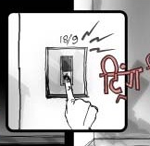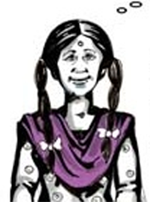Dec 27, 2025
Dec 27, 2025
Despite women's increased visibility in public spaces, better education and work opportunities, and changing social attitudes, women continue to experience physical and emotional violence, both within their homes and outside.
How does one address a crime as insidious, damaging and invasive as this in ways that are positive, interesting and relevant? This is what Jagori, the Delhi-based women's training and resource centre, had in mind when it asked documentary filmmaker Sehjo Singh to create advocacy and communication material for its ongoing campaign on violence against women.
While violence affects women across class, it is the lower middle and working classes that are the most vulnerable to it – the group that Jagori works with across northern India. Known for its attractive advocacy tools such as creative songs, diaries and posters, Jagori had a few pointers for Singh: First, the material must do more than just provide information on rights and laws; it had to focus on the social aspects surrounding violence so that the viewer would be forced to think about the issue. Second, it had to be youthful in its appeal, portable, cost-effective, interactive and communicate the non-negotiable message that violence was unacceptable even as it fostered a positive approach to taking action when one confronts such violence oneself. Finally, it had to reach out to both men and women and challenge the notion that this was a 'woman's problem'.
Keeping all these factors in mind, Singh came up with interesting, easy-to-follow interactive panels in the graphic novel style, with fictional protagonists and scenarios that the viewer can relate to. They are in Hindi and inspired from the scores of real life stories in Jagori's files of women who have emerged victorious from one form of violence or another. The violence has been divided into four broad areas: Public space, domestic/marital space, parental space and the workplace. An interactive element has been included to foster further viewer engagement.
Working on finding characters that told a compelling story on each issue, Singh created four protagonists. There's Tai, who addresses public safety; Pappu, who focuses on sexual harassment at the workplace; Meeto, who fights familial discrimination; and a man and woman, who intervene in domestic violence. "For me the characters were very important," says Singh, "They had to be recognisable, and like the viewer, troubled by violence but not know how to counter it." These protagonists then decide to 'do something' about the situation, taking action that is realistic, compelling and inspiring. By being male and female, these characters subtly imply equal male responsibility in ensuring women's safety.
Here's Tai's story board: Tai is an ordinary and yet strong, elderly woman living in an urban 'basti' (slum) and she addresses safety in public spaces. Noticing local boys harassing girls and women on her street, Tai steps in and stops it. She craftily recruits the same young boys to watch the streets, making potential perpetrators responsible for women's safety, and appoints the old men who sit playing cards and the vegetable vendors with their well-lit carts to become the eyes and ears of the community - bringing everyone together through building awareness and developing a sense of responsibility. In the last interactive panel, she invites the viewers to share their responses to the harassment women face on public transport.
 Workspace issues are seen though Pappu's eyes. Pappu is an office boy who notices with dismay the various subtle and overt ways in which women employees in his office are harassed by their male colleagues and superiors. Coming across the Supreme Court's guidelines on sexual harassment in the workplace - that lists the different forms of behaviour that count as harassment and are discriminatory on grounds of gender - he distributes copies among colleagues. This initiates discussion and debate, paving the way for increased awareness and a more gender-sensitive working environment. Copies of the guidelines, containing a small tear-away section for queries, are given away which the viewer can drop into a box.
Workspace issues are seen though Pappu's eyes. Pappu is an office boy who notices with dismay the various subtle and overt ways in which women employees in his office are harassed by their male colleagues and superiors. Coming across the Supreme Court's guidelines on sexual harassment in the workplace - that lists the different forms of behaviour that count as harassment and are discriminatory on grounds of gender - he distributes copies among colleagues. This initiates discussion and debate, paving the way for increased awareness and a more gender-sensitive working environment. Copies of the guidelines, containing a small tear-away section for queries, are given away which the viewer can drop into a box.
 The panel, 'Tring Tring', deals with domestic violence, building on the popular Bell Bajao campaign. Two neighbours, a man and a woman, ring the doorbell and interrupt a husband beating his wife. Their intervention halts the violence and while the woman takes the wife for first aid and counselling, the man addresses the husband. Through examples of other conflicts that he resolves without violence himself, the husband is made to realise that violence is not a compulsion but an active choice, one he exercises each time he beats his wife. The onus of responsibility for the violence is thus placed squarely on the perpetrator, and the presence of the male and female protagonists underlines the fact that such violence is not a woman's problem alone. There is a bell provided for the audience to ring if they agree with the panel's message.
The panel, 'Tring Tring', deals with domestic violence, building on the popular Bell Bajao campaign. Two neighbours, a man and a woman, ring the doorbell and interrupt a husband beating his wife. Their intervention halts the violence and while the woman takes the wife for first aid and counselling, the man addresses the husband. Through examples of other conflicts that he resolves without violence himself, the husband is made to realise that violence is not a compulsion but an active choice, one he exercises each time he beats his wife. The onus of responsibility for the violence is thus placed squarely on the perpetrator, and the presence of the male and female protagonists underlines the fact that such violence is not a woman's problem alone. There is a bell provided for the audience to ring if they agree with the panel's message.
 The fourth protagonist is Meeto, a bright and ambitious girl expected to abide by her parents' wishes: Privilege the comforts of her brother over her own, marry early and have children. Meeto challenges these stereotypes by studying hard, working and choosing her own life partner.
The fourth protagonist is Meeto, a bright and ambitious girl expected to abide by her parents' wishes: Privilege the comforts of her brother over her own, marry early and have children. Meeto challenges these stereotypes by studying hard, working and choosing her own life partner.
The Meeto panel, Singh recollects, was very special, as her story could have ended up as a tragic one. But after several brainstorming sessions with Jagori members, the story emerged as one that could inspire hope when told in flashback by a grown-up girl. Meeto's story uses an interesting device: It shows her having to choose between being 'good' and being 'strong', and she chooses the latter each time. The viewer is called upon to make their choice, with a red sticker.
In addition, a fifth space has been created to symbolise a woman's inner space, reflecting the ways she often inflicts violence on herself by internalising the discrimination and violence done to her. But, ultimately, this site is also about self-realisation and growth. Six inspiring real life stories from Jagori's files, of grit, struggle and success are placed here, depicting a woman's journey from “victimhood to selfhood”, as Singh says.
Printed on lightweight, roll-up flex sheets, these panels were utilised successfully during the Safe Cities campaign, which was anchored in India by Jagori. Currently they are on display in public and community spaces in Delhi. Says Suneeta Dhar, Director, Jagori, "They are part of an ongoing structural intervention on violence against women."
Jagori, which is working with UN agencies and the Delhi government to develop long-term programmes to ensure women's right to violence-free lives, feels these panels can be useful to others working in this field as well. Dhar explains, "We want these panels to travel, to be used by other NGOs, activist groups, and state governments as part of a wider initiative against violence on women." In fact, a women's groups collective in Pune (Maharashtra) has just translated these panels into Marathi – the local language - and will soon begin to use them.
Adds Madhu, head of Jagori's youth programme at Madanpur Khadar, near Delhi, "As they are visual and in an easy-to-grasp format, they are ideal for neo-literates in the communities we work in." The youth of Madanpur Khadar often intervene in instances of domestic violence in their community by throwing in a cricket ball or talking loudly in front of the house in an effort to stop the violence they see - in uncanny resemblance to the Bell Bajao advertisements.
As Nilanju, head of Jagori's Violence Intervention team, puts it, "Jagori has always been a space where women can come, create, sing, laugh and cry." It is interventions such as these that continue to make it a warm space of support, camaraderie and empowerment.
By arrangement with WFS
09-Jan-2011
More by : Shruti Parthasarathy